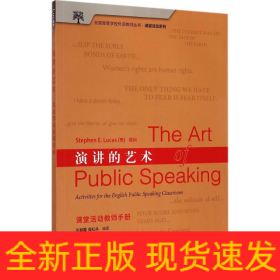
演讲的艺术课堂活动教师手册
全新正版 极速发货
¥ 31.5 6.7折 ¥ 46.9 全新
库存5件
广东广州
认证卖家担保交易快速发货售后保障
作者田朝霞,周红兵 编著 著
出版社外语教学与研究出版社
ISBN9787513556118
出版时间2015-05
装帧平装
开本16开
定价46.9元
货号1201096338
上书时间2024-11-24
- 最新上架
商品详情
- 品相描述:全新
- 商品描述
-
作者简介
田朝霞,博士,南京师范大学外国语学院副教授,南京师范大学第四届青年教师教学大赛教学十佳。中国语音教学与研究委员会理事。目前主要从事英语专业教学工作,主要教授英语语音学、语音实践、基础英语、英语写作、口语等课程。
周红兵,湖北大学外国语学院教师。
目录
Part 1 Teaching Procedures—General
Unit 1 Warm Up
Activity 1.1 A Drawing Speech of Introduction
Activity 1.2 Using the Syllabus to Create a “Talk-Friendly” Environment on the First
Day of
Class
Unit 2 Group Discussion
Activity 2.1 Creative Problem Solving—From Top to Bottom
Activity 2.2 Using New Approaches in Group Discussion Projects
Activity 2.3 Who Will Be the Next One to Get off the Boat?
Unit 3 Note-Taking Training & Listening
Activity 3.1 Learn to Use Your Own Symbols or Abbreviations to Take Notes
Unit 4 Peer Evaluation
Activity 4.1 Peer Evaluation on Introductory Speech
Activity 4.2 Peer Evaluation on the Class Recitation
Unit 5 Teacher’s Feedback
Activity 5.1 Teacher’s Feedback on Informative Speech
Activity 5.2 Teacher’s Feedback on Persuasive Speech
Unit 6 Large Class
Activity 6.1 What’s Wrong with the Speech? Understanding the Contents of the Course
Based on a Case Study.
Activity 6.2 The Outstanding Speaker Contest
Part 2 Preparation and Presentation—General
Unit 7 Speech Anxiety
Activity 7.1 It’s Not Necessary to be Nervous If I Can Do These
Activity 7.2 Public Speaking: Reducing Anxiety and Revealing a Process
Activity 7.3 How to Deal with Speech Anxiety
Unit 8 Communication Awareness
Activity 8.1 How to Maintain the Audience’s Interest During Your Speech
Activity 8.2 Send, Receive, and Draw
Unit 9 Audience Analysis
Activity 9.1 Combining Extemporaneous and Impromptu Speaking
Activity 9.2 An Alternative to Demographic Audience Analysis
Unit 10 Choosing Speech Topics
Activity 10.1 What to Say—Selecting a Topic
Activity 10.2 “FLTRP Cup”: What’s Interesting About the Topic and How to Make It More
Interesting?
Activity 10.3 Choosing Topics for Speeches: A Breath of Fresh Air
Unit 11 Information Literacy
Activity 11.1 Why ShouldYou Believe What Others Say?
Activity 11.2 Teaching Research, Teaching Speech
Activity 11.3 So What IfYou Found It on the Intemet: An Exercise in
Evaluating Web-Based Information?
Unit 12 Critical Thinking
Activity 12.1 Fact or Opinion?
Activity 12.2 Using Collaborative Controversy in the CriticalThinking Classroom
Unit 13 Organization and Outlining
Activity 13.1 The PREP Format: Four Simple Steps to a Clear Presentation
Activity 13.2 Speaking Relay Based on the"Arrow Through AssRibs" Outline Format
Unit 14 Language & Style
Activity 14.1 Powerspeak: Avoiding Ambiguous Language
Activity 14.2 Three Steps to the Artful Use of Antithesis
Unit 15 Visual Aids
Activity 15.1 Pointing Groups to PowerPoint
Activity 15.2 UpdateYour Checklist EveryWeek for Using PowerPoint
Unit 16 Delivery
Activity 16.1 Delivery Cards and Donts in Delivery
Activity 16.2 Weekly Hints for Speech Delivery
Activity 16.3 Eye Contact Shooting Gallery
Activity 16.4 What Can We Do About the Nonverbal Area in Public Speaking?
Part 3 Speeches of Specific Types
Unit 17 Introductory/"Ice-Breaker" Speeches
Activity 17.1 Self-Introduction
Activity 17.2 Who Am I?--Describing a Person
Unit 18 Informative Speeches
Activity 18.1 What Is It?--Informing Others
Activity 18.2 TellYou What I Am Good at--Challenge to Inform
Unit 19 Persuasive Speeches
Activity 19.1 Organization for Policy Speeches: Problem-Solution Order
Activity 19.2 The Problem-Cause-Solution Order
Activity 19.3 CanYou IdentityThese Logical Fallacies?
Unit 20 Speeches for Special Occasions
Activity 20.1 Introducing the Speaker
Activity 20.2 Getting to Know My Hero: The Speech of Tribute
Activity 20.3 Eulogies as a Special Occasion Speech
Unit 21 Impromptu Speeches
Activity 21.1 Speaking Impromptu: ChallengeYour Courage and Knowledge
Activity 21.2 Which Department Can Win the Fund?
Activity 21.3 Make a Public-Interest Ad for Promoting Chinas National Image
内容摘要
《演讲的艺术课堂活动教师手册》借鉴美国定期出版的名为Selections from the Speech Communication Teacher的教师手册,以真实的课堂教学实践为基础,指导演讲课堂的设计与组织,其核心理念是“Written by classroomteachers for classroom teachers”。策划和编写由Lucas教授全程指导,众多一线教师参与,旨在构建有效的演讲课堂,为英语演讲教师提供展示与分享的平台。
— 没有更多了 —












以下为对购买帮助不大的评价